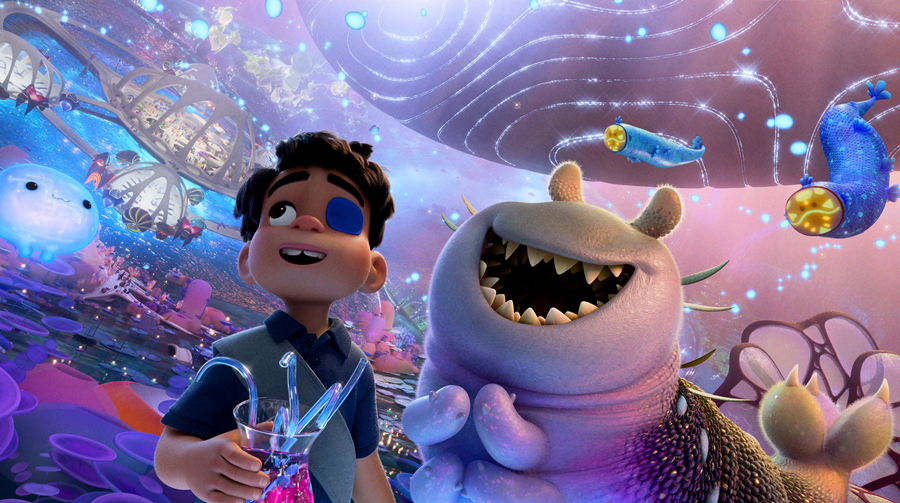Pixar's new animated feature "Elio" whisks audiences away to distant galaxies and introduces them to a host of extraterrestrial civilizations. Beneath this cosmic adventure, however, lies a poignant and uplifting tale of one boy's search for belonging.

A still from "Elio." [Picture courtesy of Pixar Animation Studios]
Producer Mary Alice Drumm recalled the early days of development, when directors were invited to pitch ideas. Director Adrian Molina posed the question: "What if the world's weirdest 11-year-old was accidentally abducted and mistaken for the leader of Earth?" Fellow filmmakers Domee Shi and Madeline Sharafian added, "What if he actually wanted to be abducted? What if he was obsessed with space?"
"That was just such a fun idea, so we kind of ran with that," Drumm said.
Shi, a Chongqing-born Chinese Canadian animator known for Pixar's "Bao" and "Turning Red," shared that the concept was inspired by real experiences and by the sense of longing she and co-director Sharafian felt while growing up.
"We were inspired by our own childhoods and the desire to find a place where we felt we belonged, where we could find our people," Shi said. "Maddie had similar obsessions with trying to go to animation school, trying to arrive at a place where we no longer felt alone, that we were among fellow nerds. That was kind of 'Elio's' emotional drive."
The film follows Elio, a lonely boy obsessed with space who dreams of being abducted by aliens to start a new life after his parents' deaths. When he is taken to the Communiverse — an interplanetary alliance — he is mistaken for Earth's leader. As he navigates an intergalactic crisis, Elio bonds with strange aliens while searching for a sense of belonging.
Sharafian highlighted Glordon as the film's most fun character, describing him as the tender-hearted son of a warlord and a friend to Elio. She applauded the design team for creating a character who is unexpectedly cute yet slightly scary, with no eyes and twelve legs. Glordon also appears in some of the film's most emotional scenes and delivers several touching moments.
Shi praised production designer Harley Jessup, known for his work on "Coco" and "Ratatouille," for pushing the team to create the visually stunning Communiverse, a unique space world unlike any seen in other movies.
"We've seen scary, dark space, but never a hopeful, beautiful, warm and welcoming space," Shi said. "This is a story about a boy whose wish comes true — to be abducted and live with aliens in a magical place where he belongs. That's what we envisioned while lighting and designing the Communiverse. It should feel colorful, organic and like somewhere you'd never want to leave once you arrive."
In the film, it is not Elio's signals that attract the attention of aliens, but the Voyager satellite launched on Sept. 5, 1977. The spacecraft carries the Golden Record, a "message in a bottle" featuring greetings from children around the world. In "Elio," the aliens receive these messages and make contact.
The film's creators based the story on extensive research and consulted astronomer Dr. Jill Tarter, a founding member of the SETI Institute, which searches for extraterrestrial intelligence.
"Dr. Jill Tarter's just so inspiring because I think she's so hopeful, and SETI, that organization is looking for life in a really hopeful way," Drumm said. "Sometimes movies portray aliens as scary or what have you. One thing Jill really talked about is just how big the universe is and how many planets there are, how likely life is out there. And then I think because Jill was connected with Carl Sagan, it led us to Voyager and other real aspects we used in the film."

The Chinese premiere of "Elio" is held at The Walt Disney Grand Theatre at Shanghai Disney Resort, June 18, 2025. [Photo courtesy of Pixar Animation Studios]
Shi said Voyager became a metaphor in the story. "Elio, he's like this lonely little satellite floating in space, looking for signals, looking for connection," Shi said. "It made sense that when Elio was grieving the loss of his family, he would feel an emotional connection with Voyager."
She added that she hopes audiences will be inspired to learn more about Voyager. "It really is incredible because it's still out there. It's still sending signals out. It's still reporting back, and maybe it'll find something by the time the movie comes out."


 Share:
Share: 




 京公網(wǎng)安備 11010802027341號(hào)
京公網(wǎng)安備 11010802027341號(hào)